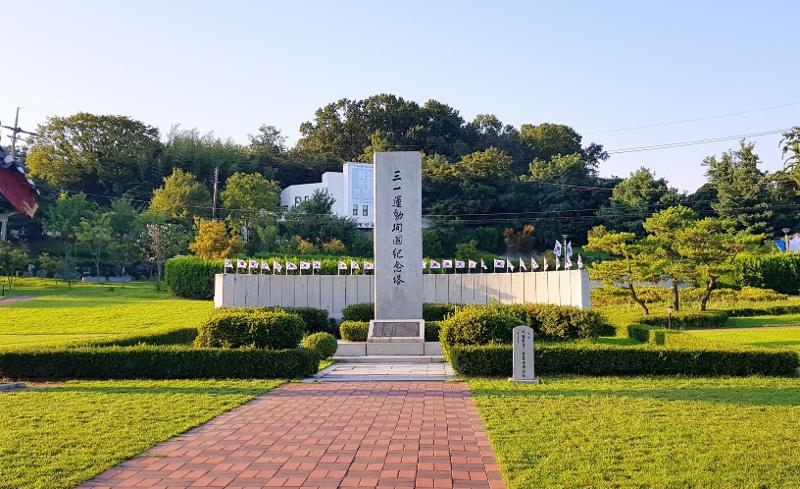[caption id="attachment_13065" align="aligncenter" width="800"] ▲ 1919년 3월 1일은 일제의 식민 지배에 항거해 독립선언서를 발표하고 만세운동을 전개함으로써 민족의 독립 의사를 전 세계에 알린 날이다. 사진은 지난해 3월 1일 서울 서대문구 서대문형무소역사관에서 진행된 104주년 삼일절 기념행사 ‘서대문, 1919 그 날의 함성’ 에서 태극기를 흔들고 있는 학생들의 모습. March 1, 1919, is when the March First Independence Movement began as Koreans flooded the streets to announce the nation's Declaration of Independence and protesting Japanese colonial rule. Shown are students on March 1, 2023, waving the national flag Taegeukgi at the "Seodaemun, the Shout of That Day in 1919" on March 1 last year on the movement's 104th anniversary at Seodaemun Prison History Hall in Seoul's Seodaemun-gu District. (Seodaemun-gu Office - 서대문구청)[/caption]
▲ 1919년 3월 1일은 일제의 식민 지배에 항거해 독립선언서를 발표하고 만세운동을 전개함으로써 민족의 독립 의사를 전 세계에 알린 날이다. 사진은 지난해 3월 1일 서울 서대문구 서대문형무소역사관에서 진행된 104주년 삼일절 기념행사 ‘서대문, 1919 그 날의 함성’ 에서 태극기를 흔들고 있는 학생들의 모습. March 1, 1919, is when the March First Independence Movement began as Koreans flooded the streets to announce the nation's Declaration of Independence and protesting Japanese colonial rule. Shown are students on March 1, 2023, waving the national flag Taegeukgi at the "Seodaemun, the Shout of That Day in 1919" on March 1 last year on the movement's 104th anniversary at Seodaemun Prison History Hall in Seoul's Seodaemun-gu District. (Seodaemun-gu Office - 서대문구청)[/caption]
1919년 3월 1일은 한민족이 일제의 식민 지배에 항거해 독립선언서를 발표하고 거족적인 만세운동을 전개한 역사적인 날이다. March 1, 1919, was a historic day on which Koreans protested Japanese colonial rule, issued a declaration of liberation and launched the March First Independence Movement.
3·1 운동은 국내외로 널리 전파돼 한국의 독립 의사를 전 세계에 알리고 식민 지배에 대한 저항 의식을 세계적으로 확산시키는 데 중요한 역할을 했다. 특히 비폭력·평화적 시위였던 3·1 운동은 중국의 5·4 운동(1919년 5월 4일 베이징 지역 학생들이 일으킨 반제국주의 혁명운동), 인도의 비폭력 불복종 운동(인도의 대표적인 독립 운동가 마하트마 간디가 주창한 비폭력 저항 운동) 등 주변 식민지 국가에서 거행된 평화적 독립운동의 촉매제가 됐다.
The non-violent and peaceful movement played a crucial role in spreading to the world Korea's desire for independence and raising awareness of resistance to colonial rule elsewhere. The campaign was widely publicized at home and abroad and inspired similar actions in neighboring countries that were ruled as colonies. For instance, the movement inspired the May Fourth Movement of China, an anti-imperialist revolutionary initiative led by students in the Beijing area on May 4, 1919, and the peaceful Civil Disobedience Movement in India led by Mahatma Gandhi.
대한민국 임시정부는 3·1 운동을 기념하기 위해 1920년에 '독립선언일'로 칭하고 국경일로 지정했다. 매년 3월 1일 정부는 기념식을 열고, 각 지역에서는 당시 해당 지역의 만세 운동을 재현하는 등 다양한 행사를 진행한다.
To commemorate the movement, the Korean Provisional Government in 1920 designated March 1 the day of the nation's independence day and a national holiday. Every March 1, the country holds a commemorative ceremony and events are held nationwide to mark the occasion like reenactments of the rallies in 1919.
3·1 운동으로부터 105년이 지난 지금, 삼일절의 의미를 되새기고 한국의 역사와 문화를 느끼고픈 외국인들을 위해 최태성 역사 강사, 정일영 서강대 사학과 교수의 추천을 바탕으로 삼일절 관련 역사 현장 세 군데를 소개한다.
On the movement's 105th anniversary this year, the following three historical sites are recommended for foreign nationals in Korea who wish to learn more about the holiday's significance and gain deeper insight into Korean history and culture. The three were selected based on recommendations from famed history lecturer Choi Tae Seong and Sogang University history professor Jeong Il-young.
1. 서울 탑골공원 - Tapgol Park in Seoul

▲ 서울 탑골공원은 서울특별시 종로구 종로2가에 위치한 국내 최초의 도심 내 공원으로, 일제에 대한 최대 규모의 민족 저항운동이었던 3·1 운동이 시작된 곳이다. 공원 내 팔각정에서 1919년 3월 1일 독립선언서가 낭독됐다. Tapgol Park, the country's first urban park and located in Seoul's Jongno-gu District, is a historical site of the March First Independence Movement, the nation's largest resistance movement against Japanese colonial rule. The Declaration of Independence was read at the park's Palgakjeong Pavilion on March 1, 1919. (Cultural Heritage Administration - 문화재청)
서울 탑골공원은 서울시 종로구에 위치한 한국 최초의 도심 내 공원으로 3·1 운동의 발상지다. Tapgol Park in Seoul's Jongno-gu District, the nation's first urban facility of its kind, is where the movement began.
1919년 3월 1일 오후 2시, 수많은 학생과 시민들은 탑골공원에 모여 민족대표들을 기다렸다. 그러나 민족대표 33인은 일제의 감시를 피하기 위해 탑골공원이 아닌 다른 장소에서 독립선언서를 낭독하고 있었다.
On March 1, 1919 at 2 p.m., masses of students and citizens gathered there to wait for the 33 signers of the Declaration of Independence, but the latter had gone elsewhere to read it to avoid Japanese surveillance.
민족대표들이 나타나지 않자 한 청년이 팔각정에 올라가 독립선언서를 낭독하기 시작했고, 이에 사람들은 "대한독립 만세"를 외치며 종로 거리로 나아갔다. 3·1 운동의 시작을 알리는 순간이었다.
Despite their absence, a young man climbed up the steps of Palgakjeong Pavilion at the park and began to read the declaration. His action prompted shouts from the crowd of "Long live Korean independence" and marches on the streets of Jongno in downtown Seoul, and this is considered the beginning of the movement.
최태성 강사는 "학생과 시민이 중심이 되어 탑골공원에서 벌어진 독립 선언식은 중요한 의미를 가진다"며 "서울에서 시작돼 전국으로, 국외로 퍼진 만세의 외침이 시작된 곳"이라고 설명했다.
"The ceremony for the Declaration of Independence at Tapgol Park led by students and citizens was significant," lecturer Choi said. "It was where the cry of 'Long live Korean independence' began and spread from Seoul to the entire country and abroad."
탑골공원에는 3·1 운동 기념탑과 벽화, 민족대표 33인 가운데 한 명으로 3·1 독립선언을 주도한 의암 손병희 선생의 동상 등이 있어 3·1 운동의 흔적을 느낄 수 있다. Other notable landmarks at the park include Movement Memorial Tower, murals on the movement and the statue of patriotic martyr Uiam Son Byong-hi, a leader of the movement and one of the 33 signers of the declaration.
2. 서대문형무소역사관 - Seodaemun Prison History Hall

서대문형무소는 일제 통감부가 대한제국에 대한 침략을 본격화하기 위해 1908년에 개소한 감옥이다. The Japanese Government-General of Korea in 1908 opened Seodaemun Prison in Seoul to advance Japan's annexation of the Korean Peninsula.
1945년 광복을 맞이할 때까지 일제의 식민 지배에 맞섰던 수많은 독립운동가들이 이곳에 갇혀 고문을 당하는 등 고초를 겪었다. 대한민국 독립을 위해 몸바친 김구 선생, 강우규 의사, 유관순 열사 등이 이곳에 수감됐다. 특히 유관순 열사는 1920년 3월 1일, 3·1 운동 1주년을 맞아 이곳 여옥사 8번 방에 함께 투옥 중이던 여성 독립운동가들과 함께 만세운동을 주도하며 불굴의 독립 의지를 드러냈다. 그리고 그해 9월 28일, 출소를 이틀 앞두고 이곳에서 옥사했다.
Many independence activists who fought Japanese colonial rule were imprisoned and tortured at the prison until national liberation in 1945. Patriotic martyrs like Kim Koo, Kang Woo-kyu and Yu Gwan-sun were detained here. On March 1, 1920, Yu marked the movement's first anniversary by leading the cry "Long live Korean independence" with fellow activists held at Cell No. 8 of the women's section of the prison, displaying her undying fervor for independence. She died there on Sept. 28 that year, just two days before her scheduled release.
서대문형무소역사관은 우리 민족의 아픈 과거를 간직한 서대문형무소의 일제강점기 시절 모습을 복원한 독립운동 관련 역사관이다. 이 곳에는 독립운동가들의 유물과 수형 기록 카드 등이 전시돼 있고, 당시 그들의 옥중 생활을 체험할 수 있는 공간도 마련돼 있다.
Seodaemun Prison History Hall is a museum honoring the movement by restoring the prison's original condition during the Japanese occupation. Artifacts and prison sentence cards of activists and freedom fighters are displayed, and cells allow visitors to see firsthand life for the imprisoned activists.
서대문형무소역사관과 인근 독립문 일대에서는 3·1 운동 105주년을 맞이해 오는 3월 1일과 2일 삼일절 기념행사인 ‘서대문, 1919 그날의 함성’이 개최된다. The museum and the area around Dongnimmun (Independence) Gate from March 1-2 host the commemorative event "Seodaemun, the Shout That Day in 1919" to mark the 105th anniversary of the movement.
3. 제암리 3·1운동 순국 유적지 - Historic Site of March First Independence Movement in Jeam-ri, Hwaseong

▲ 경기도 화성시 제암리는 일제가 군사 경찰과 군대를 동원해 독립운동가들을 무자비하게 탄압하고, 잔인하게 학살한 곳이다. 사진은 1919년 4월 15일 제암리·고주리 민간인 학살 사건이 일어난 제암교회 터 근처에 세워진 3·1운동순국기념탑. The village of Jeam-ri in Hwaseong, Gyeonggi-do Province, is where the worst massacre during Japanese colonial rule of Korea occurred during the movement. A memorial tower for the movement's patriotic martyrs stands near Jeam-ri Protestant Church where the incident occurred. (Federation of Korea Culture Center's Local & Culture - 한국문화원연합회 지역N문화)
경기도 화성시에 있는 제암리는 3·1 운동이 한창 전국적으로 확산할 시기에 일제가 주민들을 가장 잔인한 방법으로 탄압한 학살의 현장이다. At the height of the movement, the village of Jeam-ri in Hwaseong, Gyeonggi-do Province, saw the most brutal act of repression during the movement by the Japanese colonial government.
3·1 운동은 그 날 하루만 일어난 것이 아니다. 한반도 전역을 넘어 일본과 연해주 지역으로 전파되었으며, 1여 년 간 지속되었다. 이에 일제는 경찰과 군대를 동원해 무자비하게 탄압했고, 그 과정에서 제암리·고주리 민간인 학살 사건이 발생했다.
The movement extended far beyond a single day, spreading across the peninsula to reach Japan and Russia's Primorsky Krai and continuing for about a year. The Japanese government responded with brute force by mobilizing police and military personnel, resulting in massacres in the villages of Jeam-ri and Goju-ri.
1919년 4월 15일 일본군은 기독교와 천도교 남자 신자 20여 명을 제암리에 위치한 교회당에 모이게 했다. 이어 교회당의 출입문과 창문을 잠그고 안에 있는 사람들을 총칼로 학살한 뒤 교회당에 불을 질렀다. 이때 불 속에서 뛰쳐나오거나 길에 나왔다가 달아나는 사람에 대해서는 발포하거나 총검으로 찔러 죽이는 만행을 보였다.
On April 15, 1919, Japanese soldiers forced around 20 male Christians and Cheondoists into Jeam-ri Protestant Church and locked the doors and windows there. The troops then slaughtered them with bayonets and guns and burned the church afterwards, preventing any of the victims from escaping either the fire or the building by shooting or bayoneting them.
이때 불탄 예배당 터에는 순국 기념탑이 세워지고 그 일대는 제암리 3·1 운동 순국 유적지로 지정됐다. 또 유적지 근처에는 현재는 휴관 중인 제암리 3·1운동 순국기념관이 있으며 국내외 관계자료가 전시되어 2023년 4월까지 국민 교육의 현장으로 활용됐다. 해당 기념관은 사적지 정비 및 신규 시설 건립 과정을 거쳐 오는 4월 '화성시독립운동기념관'으로 재개관될 예정이다.
A memorial tower for the patriotic martyrs is at the site of the church and the area was designated Historic Site of the March First Independence Movement in Jeam-ri, Hwaseong. A nearby memorial hall used for public education until April last year displays domestic and foreign materials related to the movement. It will be reopened in April this year under the name Hwaseong Independence Movement Memorial Hall following renovation of the site and construction of new facilities.
윤승진 기자 scf2979@korea.kr
By Yoon Seungjin, scf2979@korea.kr



.jpg)





0 comments: